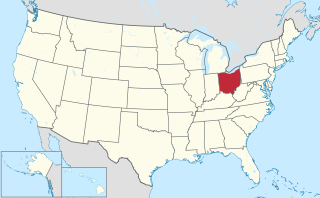
The 1828 United States presidential election was the 11th quadrennial presidential election. It was held from Friday, October 31 to Tuesday, December 2, 1828. It featured a repetition of the 1824 election, as President John Quincy Adams of the National Republican Party faced Andrew Jackson of the Democratic Party. Both parties were new organizations, and this was the first presidential election their nominees contested. This election saw the second rematch in presidential history, something that would not occur again until 1840.

Thomas Corwin, also known as Tom Corwin, The Wagon Boy, and Black Tom was a politician from the state of Ohio. He represented Ohio in both houses of Congress and served as the 15th governor of Ohio and the 20th Secretary of the Treasury. After affiliating with the Whig Party, he joined the Republican Party in the 1850s. Corwin is best known for his sponsorship of the proposed Corwin Amendment, which was presented in an unsuccessful attempt to avoid the oncoming American Civil War.

The Ohio Democratic Party (ODP) is the affiliate of the Democratic Party in the U.S. state of Ohio. Summit County Council President Elizabeth Walters has been the party's chairwoman since January 2021.

The 1828–29 United States House of Representatives elections were held on various dates in various states between July 9, 1828, and October 5, 1829. Each state set its own date for its elections to the House of Representatives before the first session of the 21st United States Congress convened on December 7, 1829. Elections were held for all 213 seats, representing 24 states.

William Creighton Jr. was the 1st Secretary of State of Ohio, a United States representative from Ohio and a United States district judge of the United States District Court for the District of Ohio.
Political control of Ohio has oscillated between the two major parties. Republicans outnumber Democrats in Ohio government. The governor, Mike DeWine, is a Republican, as are all other non-judicial statewide elected officials: Lieutenant Governor of Ohio Jon A. Husted, Ohio Attorney General Dave Yost, Ohio State Auditor Keith Faber, Ohio Secretary of State Frank LaRose and Ohio State Treasurer Robert Sprague.

Union Township is one of the 14 townships of Mercer County, Ohio, United States. The 2020 census found 1,330 people in the township.

David Austin Starkweather was an American lawyer and politician who was a U.S. Representative from Ohio and a U.S. diplomat. He served two non-consecutive terms in the U.S. House of Representatives in the mid-19th century and was United States Ambassador to Chile during the presidency of Franklin Pierce.

Samuel Wilson Parker, was an American lawyer and politician who served two terms as a U.S. Representative from Indiana from 1851 to 1855.
Daniel Duncan was a U.S. Representative from Ohio.
David Chambers was a United States Representative from Ohio.

John Woods was a U.S. Representative from Ohio.

The 1828 United States presidential election in Ohio took place between October 31 and December 2, 1828, as part of the 1828 United States presidential election. Voters chose 16 representatives, or electors to the Electoral College, who voted for President and Vice President.

The 1832 United States presidential election in Ohio took place between November 2 and December 5, 1832, as part of the 1832 United States presidential election. Voters chose 21 representatives, or electors to the Electoral College, who voted for President and Vice President.

The 1828 United States elections elected the members of the 21st United States Congress. It marked the beginning of the Second Party System, and the definitive split of the Democratic-Republican Party into the Democratic Party and the National Republican Party. While the Democrats cultivated strong local organizations, the National Republicans relied on a clear national platform of high tariffs and internal improvements. Political scientists such as V.O. Key Jr. consider this election to be a realigning election, while political scientists such as James Reichley instead see the election as a continuation of the Democratic-Republican tradition. Additionally, this election saw the Anti-Masonic Party win a small number of seats in the House, becoming the first third party to gain representation in Congress.

Following is a table of United States presidential elections in Ohio, ordered by year. Since its admission to statehood in 1803, Ohio has participated in every U.S. presidential election.

Electoral history of William Henry Harrison, who served as the 9th president of the United States (1841); United States Minister to Gran Colombia (1828–1829); United States senator from Ohio (1825–1828); United States representative from Ohio (1816–1819) and as the first governor of the Indiana Territory (1801–1812).
The 1816 United States presidential election in Indiana took place between November 1 to December 4, 1816, as part of the 1816 United States presidential election. The state legislature chose three representatives, or electors to the Electoral College, who voted for President and Vice President.

In Ohio's 6th district, incumbent William Creighton Jr. resigned before December 19, 1828 when he was given a recess appointment to be a United States District Judge. He was also nominated for the judgeship, but that appointment was not approved by the U.S. Senate by February 1829. Creighton was already elected to the next term and was reseated in his old position when the next Congress began in March 1829.















